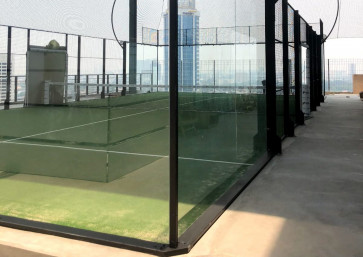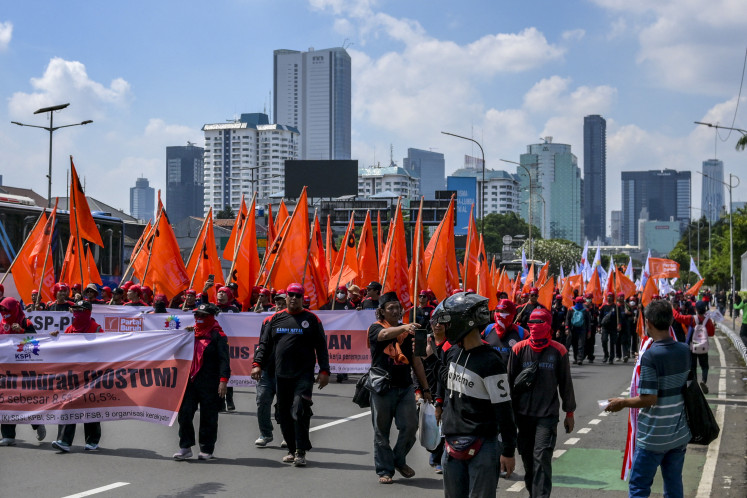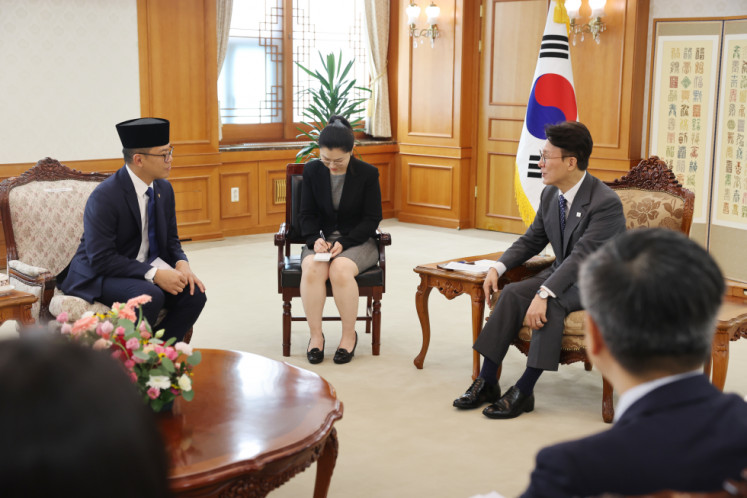Popular Reads
Top Results
Can't find what you're looking for?
View all search resultsPopular Reads
Top Results
Can't find what you're looking for?
View all search resultsMiracle plant heals wounds and economies
BALM WEEDING: Women works in one of PT Alove Bali's aloe vera plantations in Blahbatuh, Gianyar
Change text size
Gift Premium Articles
to Anyone
BALM WEEDING: Women works in one of PT Alove Bali's aloe vera plantations in Blahbatuh, Gianyar. (JP/Trisha Sertori)Long polysaccharides in the North African aloe vera plant could help reduce illness in HIV/AIDS and cancer patients. At the same time the cactus plant may also help reduce poverty in some of Bali's dry areas.
Bali is currently producing around 15,000 liters of aloe vera weekly for the European market, according to Floris Schaaper, an engineer with aloe vera producer, PT Alove Bali. That volume, harvested on 80 hectares, is expected to grow to more than 30,000 liters weekly in the coming months.
"By 2012 the plan is to have 500 hectares of aloe vera producing 20 million liters per year. That can be processed at this existing factory," said Schaaper of the PT Alove Bali factory in Blahbatuh, Gianyar. The modern factory will be formally opened April 5.
Employing more than 200 people across its aloe vera farming and processing system, Alove Bali is having a positive economic impact on the families of Blahbatuh and other areas under aloe vera cultivation.
"We are planting in areas where rice is no longer a viable farm crop due to a dropping water table. The move to aloe vera means farmers can continue to work their lands," said PT Alove Bali coordinator, Made Karang. He points out aloe vera provides farmers an income three times higher than rice grown on marginal lands.
"PT ALove Bali was started by Hank and Peter Zwanenberg from Holland some years ago. They built a villa here in 1999 and saw the local people did not have jobs. They wanted to find a way to create employment. They saw the employment situation grow even worse after the Bali bomb in 2002," explains Karang of the beginnings of aloe vera in Bali.
With rice fields in their immediate areas lying fallow due to lack of water, the Zwanenberg's turned their attention to low water farming. A worldwide shortage of aloe vera and strong European markets suggested the hardy cactus could be the ideal product that would offer sustainable farming into the future for Bali's dry land farmers.
"That was three years ago. We now have 30 hectares under lease and a further 50 hectares being farmed cooperatively," said Karang.
The cooperative farming system offers farmers the opportunity to shift from marginal rice growing in areas of low water to aloe vera farming at no cost.
"We give farmers the initial aloe vera plants and they are also paid four million rupiah per hectare every six months to maintain the plants until they are old enough to harvest. From that time on they are paid per kilo," said Karang.
Schaaper adds that once aloe vera has been planted it reproduces so new plants are always available for farmers. Only the five to nine largest leaves of aloe vera are harvested and the plant continues to produce for 10 to 15 years. Farmers can plant out young aloe vera taken from mature plants so they have a continuous crop.
With increased production, PT Alove Bali hopes to export into the lucrative Asian market, as well as other countries such as the United States. Aloe vera is used worldwide in cosmetics, shampoos, health drinks and medical products. Its use in treating burns is also well documented.
According to Schaaper, it is the very long Alverose polysaccharides in aloe vera that are doing the miracle work. Polysaccharides are complex carbohydrates made up of many monosaccharides, however, only aloe vera has the Alverose polysaccharide that is believed to stimulate the reproduction of white blood cells. White blood cells are responsible for healthy immune systems and wound healing.
Recent scientific studies on rats established a 40 percent faster wound healing rate using aloe vera. Netherlands-based aloe vera company Bioclin is currently running aloe vera trials on HIV and oral wound patients in South Africa.
"Bioclin is setting up research projects in South Africa to research HIV/AIDS treatments using aloe vera," said Schaaper.
However, Schaaper warns that people claiming miracle cures with aloe vera raise concerns. "I am very skeptical -- some people claim they can heal people with serious diseases with aloe vera. But you must be very careful and use the proper research. But aloe vera is a very old treatment. People say Alexander the Great used aloe vera and even invaded a country to get aloe vera as a treatment for his soldiers,"
To aloe vera's farming families, the cactus is already proving to be a miracle, offering them a growing and sustainable economy.










